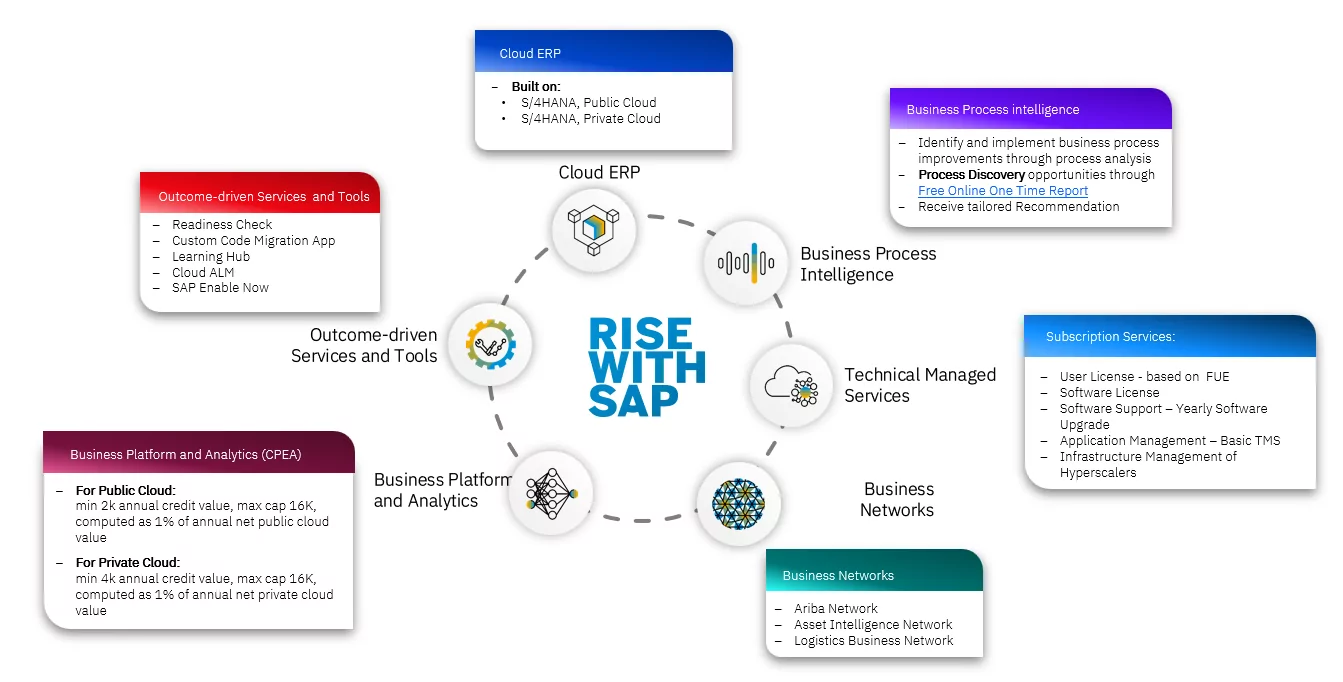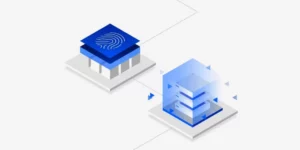
RISE with SAP has not only been a major cloud player in recent years, it’s also become the standard cloud offering from SAP across different products.
But when assessing what it takes to onboard into RISE with SAP, there are multiple points to consider. Especially important is a good understanding of the RACI split around Standard, Additional and Optional Services, along with relevant CAS (Cloud Application Service) packages.
If you’re wondering whether RISE with SAP is the right solution for you, consider the following scenarios:
Data centre move
You’re looking to move from Capex to Opex in IT spend or have an end-of-data centre contract which can end up triggering evaluation for alternate hosting options —this time, a hyperscaler-based journey (Azure, AWS, GCP, IBM Cloud® and so forth). Also consider the cost of hardware refresh and for possible opportunities around on demand cloud computing.
S/4HANA contract conversion
You’re in your journey towards adoption of S/4HANA either with Greenfield, Brownfield or Bluefield by planning a potential contract renegotiation and restructuring with SAP, then RISE with SAP is the only contract presented by SAP (majority of the time) to customers offering S/4HANA capabilities and a move to cloud computing.
Enabling true transformation
You’re on the lookout for adoption of industry best practices along with the capabilities of process mining and process discovery to both simplify and standardize the process flows. From a business and IT perspective, this helps in cycle time and eventually price per business object.
M&A and divestiture
You have a potential ask of simplifying the divestiture of Company Codes and with that, the split of IT systems with ease of license segregation.
System consolidation
You want to reduce the solution footprint and by doing so, reduce infrastructure cost and help shift toward a single source of truth across different components.
License audit gap/shelfware
You’re looking for a long-term solution that’s not only subscription-based, but can also address potential compliance gaps.
IT project issues
You’d like to worry less about physical provisioning of capacity within your data centre and rely more on faster onboarding of new resources in terms of on-demand capacity.
End to end security
You’re required to maintain gold standard of security both from a platform and application point of view, cutting across different security requirements.
IT Ops issues
You don’t want to deal with the challenges in managing multiple vendors and SLAs.
Industry focus
To complement your current IT setup and add operating flexibility, you’re also looking to address the rapid demand for cloud ERP in industries such as healthcare, retail, education and telecom. In addition, you want an automated resource management and industry specific functions such as sales and customer support at the core of operations. The image below shows what’s included within RISE at a high level.

To top it off, SAP recently announced “Grow with SAP,” an offering that includes products, best practice support, adoption acceleration services, community and learning opportunities to help use SAP S/4HANA public cloud edition with speed, predictability and continuous innovation.
What else should you know about RISE with SAP?
RISE with SAP comes with different activities, included as part of the standard/ tailored RACI published by SAP. These activities are categorized as:
- Standard: Default activities that maintain systems without additional charge such as DB, network, platform and system maintenance. More details about roles and responsibilities here.
- Additional: One-time activities—such as additional DR testing—required to be performed by SAP beyond what’s standard
- Optional: Both one-time and recurring impacts on the solution, such as adding additional memory or upgrading on size and scale.
- Cloud Application Services (CAS) packages: Activities which a client might be able to handle within their IT team internally, or with the vendor who might already have been a part of their IT landscape. These activities may include supporting the client’s transport management, release version upgrades and test management needs.
Based on the requirements, it’s not only additional CAS packages to consider—it’s also the SAP and non-SAP systems you don’t want to include into the RISE landscape. This could be due to multiple reasons, primarily, certain combinations of hardware and DB might not be supported in RISE.
To address this, consider ManagePlus, which maintains similar standards to RISE without some of the incentives which may not be required. A few other compelling reasons in favor of ManagePlus:
You have not yet decided if RISE with SAP is appropriate for your business
- You have multiple add-ons which might not be allowed into RISE with SAP
- You want a single vendor to take responsibility for both RISE-based workloads and non-RISE-based workloads
- You would like to still transition into cloud services before making a jump into S/4HANA, but want to make sure you don’t end up paying twice—once for the current move through ManagePlus, and at a later point, into RISE with SAP
- You’re looking for the same landing zone with pre-defined architectural patterns being leveraged for a true hybrid cloud deployment
As announced earlier, IBM® is at the frontier, deploying RISE with SAP as a premium supplier successfully delivering RISE with SAP both from a cloud provisioning and from a technical managed services point of view. As part of the breakthrough partnership with IBM for RISE with SAP, global clients have been successfully provided with advisory, support and implementation services including the CAS package related services.
To add onto these great solutions and services, clients have also been given a comprehensive end-to-end solution under “ManagePlus,” which can address all of the above pain points around your aspiration to be RISE-ready, while still deciding when to move to RISE with SAP. ManagePlus also covers SAP and non-SAP workloads, which are not on RISE, but can maintain similar standards. Last but not least, the scenario around CAS package-based scope to support your RISE with SAP based scope.
We leverage our master control plane driven approach guided by AI and automation to support your requirements both for the build and manage on SAP and non-SAP workloads. This enables you to have a seamless transition across the systems with a single vendor-based experience and with improvement in Mean time to Diagnose (MTTD) and Mean Time to Resolve (MTTR). The control plane also allows you to easily extend across multiple hyperscalers using the same architectural patterns established earlier. This provides the ease of maintenance and repeatability of effort, without looking into different integration points between each solution.
This solution brings the best capabilities to the forefront when it comes to industry best practices, industry solutions, technical core operations, migration/implementation of the functionality, functional/technical application management services and adoption of AI. To help you achieve no-touch and low-touch operations model. We leverage our SAP-certified Digital Operations framework at the core of the solution to generate insights and reduce the noise when it comes to the most complex landscape management-based functionality.
The following are the benefits of using this solution either with RISE with SAP or beyond RISE with SAP:
- Provides a consistent platform of less than 3 days for system provisioning end-to-end
- Provides a single platform for not only RISE with SAP-based workloads, but for all systems both SAP and non-SAP with same standards as RISE with SAP
- Well-defined CAS package-related services around system monitoring, job scheduling/monitoring, print setup and monitoring, transport management, ChaRM maintenance and custom add-on management (along with other issues around usage of DBs, such as Oracle, DB2 with AIX and other operating systems)
- 50–60% improvement in MTTD and MTTR leveraging AI
For more information, reach out to see how this new solution can help your journey to cloud computing, or to RISE with SAP and beyond.
Learn more about RISE with SAPWas this article helpful?
YesNo
IBM Newsletters
Get our newsletters and topic updates that deliver the latest thought leadership and insights on emerging trends.Subscribe now More newsletters
- SEO Powered Content & PR Distribution. Get Amplified Today.
- PlatoData.Network Vertical Generative Ai. Empower Yourself. Access Here.
- PlatoAiStream. Web3 Intelligence. Knowledge Amplified. Access Here.
- PlatoESG. Carbon, CleanTech, Energy, Environment, Solar, Waste Management. Access Here.
- PlatoHealth. Biotech and Clinical Trials Intelligence. Access Here.
- Source: https://www.ibm.com/blog/manageplus-your-journey-before-with-and-beyond-rise-with-sap/
- :has
- :is
- :not
- :where
- $UP
- 1
- 11
- 20
- 2023
- 2024
- 28
- 29
- 30
- 300
- 36
- 400
- 41
- 4th
- 66
- 7
- 8
- 9
- a
- Able
- About
- above
- acceleration
- According
- Achieve
- across
- activities
- add
- Add-on
- adding
- addition
- Additional
- address
- Adopting
- Adoption
- Advertising
- advisory
- AI
- All
- allowed
- allows
- along
- already
- also
- amp
- an
- analytics
- and
- announced
- anyone
- Application
- approach
- appropriate
- architectural
- architecture
- ARE
- around
- article
- AS
- ask
- aspect
- aspiration
- Assessing
- At
- audit
- author
- Automated
- Automation
- average
- AWS
- Azure
- back
- based
- basic
- BE
- because
- become
- been
- before
- behind
- being
- below
- benefits
- BEST
- best practices
- Better
- between
- Beyond
- Billion
- Blog
- Blue
- both
- breakthrough
- Brings
- build
- business
- business continuity
- businesses
- but
- button
- by
- CAN
- capabilities
- Capacity
- carbon
- card
- Cards
- CAT
- Category
- Centers
- centre
- certain
- challenges
- charge
- check
- Choose
- choosing
- circles
- class
- client
- clients
- closely
- Cloud
- cloud computing
- cloud services
- codes
- colleagues
- color
- COM
- combinations
- comes
- community
- company
- compelling
- Complement
- complex
- compliance
- components
- comprehensive
- computing
- Connect
- Consider
- considering
- consistent
- Container
- continue
- continuity
- continuous
- contract
- control
- Core
- Cost
- Costs
- could
- covers
- CSS
- Current
- custom
- customer
- Customer Support
- Customers
- cutting
- cycle
- data
- data centers
- data centre
- data scientist
- Date
- Days
- DBS
- deal
- decided
- Deciding
- Default
- definitions
- deliver
- delivering
- Demand
- dense
- density
- deploying
- description
- desk
- detailed
- details
- Developer
- dharma
- difference
- differences
- different
- digital
- disaster
- discovery
- do
- does
- doing
- Dont
- dr
- driven
- due
- each
- Earlier
- ease
- easily
- edition
- Education
- effort
- either
- else
- emerging
- empowers
- enables
- end
- end-to-end
- English
- Enter
- Enterprise
- ERP
- especially
- established
- Ether (ETH)
- evaluation
- Even
- Event
- eventually
- everyday
- executive
- Exit
- expected
- experience
- explore
- explosion
- extend
- fact
- factory
- false
- faster
- favor
- February
- few
- First
- FLEET
- Flexibility
- Flows
- Focus
- follow
- following
- fonts
- Footprint
- For
- Forecast
- forefront
- forth
- Framework
- from
- Frontier
- functionality
- functions
- future
- gaps
- Gartner
- GCP
- Gen
- generate
- generator
- get
- given
- Global
- globe
- Gold
- Gold Standard
- good
- great
- greenfield
- Grid
- Grow
- guided
- handle
- Hardware
- Have
- Heading
- healthcare
- height
- help
- helpful
- helps
- High
- high-performing
- hosting
- How
- HTML
- HTTPS
- Hybrid
- hybrid cloud
- IBM
- IBM Cloud
- ICO
- ICON
- if
- image
- Impacts
- implementation
- important
- improvement
- in
- Incentives
- incidents
- include
- included
- includes
- Including
- index
- industries
- industry
- information
- Infrastructure
- Innovation
- insights
- integration
- Intel
- internally
- Internet
- internet of things
- into
- intrinsic
- introduced
- iot
- issues
- IT
- January
- Job
- journey
- jpg
- jump
- just
- Key
- Know
- landing
- landscape
- large
- Last
- later
- latest
- Leadership
- LEARN
- learning
- least
- less
- Level
- Leverage
- leveraged
- leveraging
- License
- like
- LINK
- local
- locale
- long-term
- looking
- maintain
- maintains
- maintenance
- major
- Majority
- make
- MAKES
- Making
- manage
- managed
- management
- managing
- master
- Match
- max-width
- May..
- mean
- member
- Memory
- metal
- might
- min
- Mining
- minutes
- mix
- Mobile
- mobile phone
- model
- monitoring
- more
- most
- move
- multiple
- nationally
- Navigation
- needs
- network
- New
- new solution
- Newest
- Newsletters
- Noise
- nothing
- now
- object
- objects
- of
- off
- offering
- Offerings
- on
- On-Demand
- Onboard
- Onboarding
- ONE
- only
- operating
- operating systems
- Operations
- opportunities
- Optimize
- optimized
- Options
- or
- oracle
- organization
- organizations
- Other
- our
- outlines
- outside
- overhead
- own
- package
- packages
- page
- Pain
- Pain points
- part
- partner
- Partnership
- patterns
- paying
- per
- performance
- performed
- person
- perspective
- phone
- PHP
- physical
- Plagues
- plan
- plane
- planning
- plans
- platform
- plato
- Plato Data Intelligence
- PlatoData
- player
- plugin
- Point
- Point of View
- points
- policy
- position
- possessions
- possible
- Post
- potential
- practice
- practices
- Premium
- Prepare
- presented
- prevent
- price
- primarily
- primary
- process
- process mining
- processors
- Products
- Products and Services
- project
- provided
- provides
- public
- Public cloud
- published
- rapid
- Reading
- reasons
- recent
- recently
- recovery
- recurring
- reduce
- related
- relatively
- release
- relevant
- rely
- required
- Requirements
- resides
- resolve
- resource
- Resources
- responsibilities
- responsibility
- responsive
- restructuring
- retail
- return
- right
- Rise
- Risk
- risk management
- robots
- roles
- routinely
- s
- sales
- same
- sap
- Scale
- scenario
- scenarios
- Scientist
- scope
- Screen
- scripts
- seamless
- security
- see
- senior
- seo
- server
- servers
- service
- Services
- setup
- shift
- shot
- should
- Shows
- similar
- Simple
- simplify
- simplifying
- single
- site
- Sitting
- situation
- Size
- small
- So
- solution
- Solutions
- some
- Source
- specific
- speed
- spend
- Spending
- split
- Sponsored
- squares
- standard
- standards
- start
- Steps
- Still
- storage
- strategies
- Strategy
- street
- subscribe
- successful
- Successfully
- such
- supplier
- support
- Supported
- Supporting
- sure
- SVG
- system
- Systems
- tailored
- Take
- takes
- talking
- team
- Technical
- telecom
- terms
- tertiary
- test
- than
- thanks
- that
- The
- The Future
- the world
- their
- theme
- then
- There.
- These
- they
- thing
- things
- this
- this week
- thought
- thought leadership
- Through
- time
- Title
- to
- top
- topic
- Total
- toward
- towards
- transition
- transport
- Trends
- triggering
- true
- truth
- two
- type
- types
- under
- understanding
- Unexpected
- units
- Updates
- upgrades
- URL
- Usage
- use
- using
- vendor
- vendors
- version
- View
- vs
- W
- want
- Warehouse
- we
- week
- What
- when
- whether
- which
- while
- WHO
- will
- with
- within
- without
- witnessed
- wondering
- WordPress
- Work
- world
- worldwide
- worry
- worth
- would
- written
- years
- yet
- you
- young
- Your
- zephyrnet
- zone
















